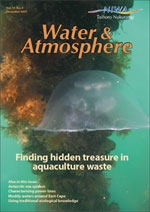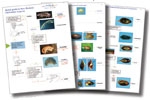PDF of this article (256 KB)


New ‘Quick guides’ to freshwater invertebrates
We’ve added a dozen new guides to NIWA’s successful series of pictorial identification keys for New Zealand’s freshwater flora and fauna. These include two guides to mites by Dean Olsen (Cawthron Institute), three to the crustaceans (Amphipoda, Copepoda and Isopoda) by Graham Fenwick and Anna John (NIWA), and six guides to adults and larvae of freshwater beetle families (including Dytiscidae and Hydrophilidae) and one to common freshwater snails by Brian Smith (NIWA). These new keys were produced with funding from the Department of Conservation Terrestrial and Freshwater Biodiversity Information System (TFBIS) programme.
All ‘Quick guides’ can be found on the NIWA website: www.niwa.co.nz/rc/prog/freshbiodiversity/tools#id
For further information, contact: Brian Smith, 07 856 1756, [email protected]
Bringing IPY into the classroom

The third International Polar Year runs from 2007 to 2009. In February and March 2008, NIWA’s research vessel Tangaroa will be in Antarctic waters as part of the IPY, specifically with CAML, the international Census of Antarctic Marine Life programme. The scientists on board will be studying the biodiversity and ecology of the marine environment and reporting directly back to the classroom via the Internet.
The Science Learning Hub, an educational website, will host reports from the ship. These reports will focus on eight themes chosen to provide the best links between the science being undertaken on the voyage and the New Zealand science curriculum for years 9 and 10. They are:
- the research vessel
- life on board
- fish
- benthic organisms
- seamounts
- ocean currents
- plankton
- food webs.
The themes will be added to the website sequentially over the eight weeks of the voyage. Each theme will include an introductory article, a daily blog from the ship, images, sound files, videos from the ship, a section for students to ask questions of scientists and crew onboard, and links to related teaching resources and student activities. The IPY material will remain on the website as a teaching resource after the voyage has been completed.
For further information, go to www.niwa.co.nz/edu/ipy Or contact: Dr Julie Hall, 07-856 1709, [email protected]
Training at NIWA
NIWA offers a wide range of courses each year. They are presented at a number of venues according to need and level of interest, and in some instances can include in-house training at your premises. Courses offered in the next six months include:
Identifying wetland sedges and rushes, 29–30 January,Hamilton
Identifying algae in rivers and lakes, 13–14 February,Christchurch
Identifying aquatic macrophytes, 19–20 February,Christchurch
Introduction to stream invertebrates, 14 March, Hamilton
Advanced flow regime analysis, March (3 days), Hamilton
General environmental data logging, 19–20 March,Christchurch
Identifying marine macroalgae, April (2 days), Wellington
Optimising data quality from environmental monitoringstations, 16 April, Christchurch
Scientific diver training course, June (8 days), Rotorua
For further information, contact: NIWA Training Coordinator phone 0800 RING NIWA (0800 746 464) or email [email protected]
